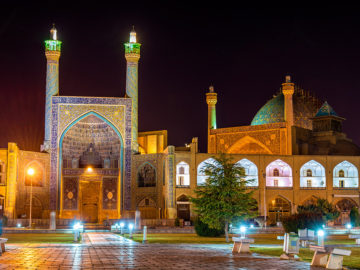
Jameh Mosque of Isfahan, Isfahan Province, Iran
Photo by Alexandre Rotenberg / Sutterstock
Masjed-e Jameh of Isfahan is a museum of architecture since it embraces twelve centuries of Iranian mosque architecture. Even though the construction of the mosque is attributed to the 9th century CE, many believe that the mosque is built upon a pre-Islamic fire temple. This postulation is because of the excavation of a decorated Sassanid (224 – 650 CE) column base. When Islam was introduced to Iran, every Islamic art style left a trace on this mosque. Its majority of architecture and decorations were carried out by two major Iranian dynasties of Seljuk and Safavid.
Leveraging the four-iwans style of Sassanid palace architecture, the Jameh mosque of Isfahan underwent the first adaptation in the religious constructions. The four iwans called Sahib on the south, Dervish on the north, Ostad on the west, and Shagerd on the east sides of the mosque are all ornamented with Muqarnas (Stalactite vaulting) and Karbandi (a geometric decoration type).

Plan of Masjed-e Jameh of Isfahan – Persia Advisor Travels
by Negar Ganji
Decorated with stunning stucco, shabestan is close to the southern iwan and involves a forest of columns dating back to Daylamites (10th and 11th centuries CE). Unique in the time of Seljuk, the Nezam al-Molk dome was the prototype of double-shell ribbed domes that further enabled architects and artists to add further decorations to the dome. The iwan in front of the dome was decorated with large Muqarnas of 12th centuries CE and artworks of the ages of Qara Qoyunlu and Safavid dynasties. In the northern iwan, there is an elegant brick dome constructed by Taj al-Molk, another courtier of Malik Shah I and the rival of Nizam al-Molk.
The complex houses various mihrabs among which the most famous is the one with exquisite geometric and floral stucco design in the western iwan built under the command of Ilkhanid Sultan Uljeito. A Timurid Winter Hall with the application of alabaster skylight is situated next to the room of Uljeito.
Masjed-e Jameh of Isfahan was registered in UNESCO World Heritage list in 2012.


